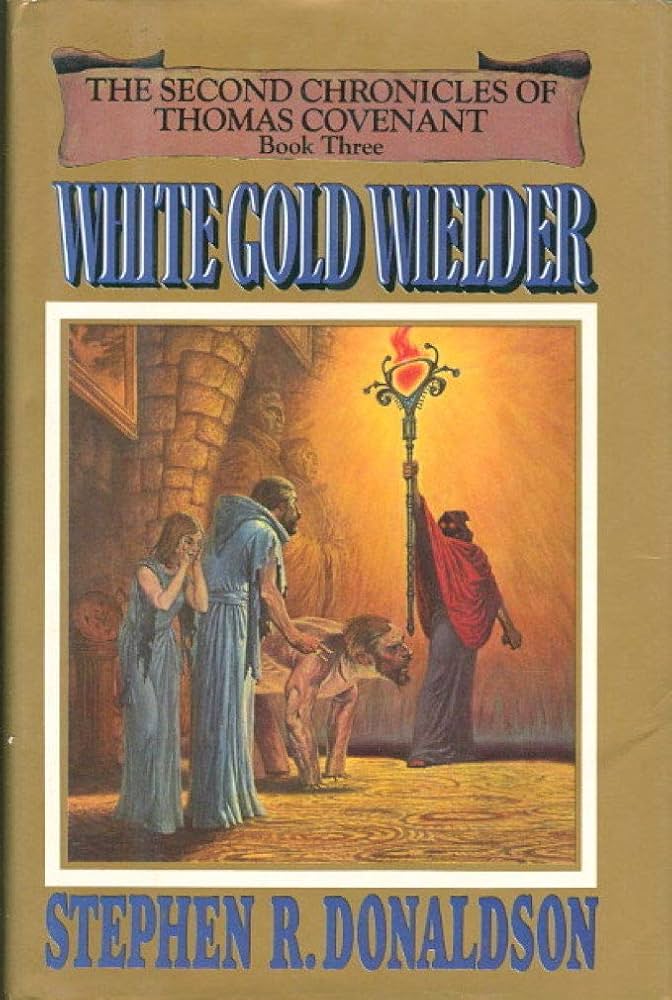
White Gold Wielder
Chapter 21: Part Two — Restoration
by Donaldson, Stephen R.The chapter titled “Part Two — Restoration” serves as the epilogue to “Covenant [6] White Gold Wielder,” focusing on themes of renewal and resolution. It marks the culmination of the protagonist’s journey, emphasizing the restoration of balance and order after a period of turmoil. The brevity of the chapter suggests a reflective tone, allowing readers to absorb the significance of the preceding events. The title itself, “Restoration,” hints at the resolution of conflicts and the return to a state of harmony.
The epilogue underscores the transformative power of the protagonist’s actions, symbolized by the white gold. This artifact, central to the narrative, represents both destruction and healing, mirroring the duality of the protagonist’s role. The restoration process is not just physical but also emotional and spiritual, affecting the world and its inhabitants. The chapter’s sparse content invites readers to contemplate the broader implications of the story’s conclusion, leaving room for interpretation.
Despite its conciseness, the chapter effectively conveys a sense of closure. The restoration theme resonates with the overarching narrative of redemption and sacrifice. The protagonist’s journey, fraught with challenges, ultimately leads to a renewed world, suggesting that even the greatest conflicts can yield positive change. The epilogue’s minimalist style reinforces the idea that some resolutions are best left unspoken, allowing the reader to infer the deeper meaning.
In summary, “Part Two — Restoration” provides a poignant and understated conclusion to the saga. It highlights the protagonist’s legacy and the enduring impact of their choices. The chapter’s focus on restoration serves as a reminder of the cyclical nature of struggle and renewal. By leaving certain elements open-ended, it encourages readers to reflect on the broader themes of the story, making it a fitting end to the narrative.
FAQs
1. What is the significance of the title “Restoration” in the epilogue of this chapter?
Answer:
The title “Restoration” suggests a thematic conclusion to the chapter, implying the return or renewal of something that was lost or damaged. In the context of “Covenant [6] White Gold Wielder,” restoration likely refers to the resolution of key conflicts, the healing of the world or characters, or the re-establishment of balance. While the provided chapter content is minimal, the term “Restoration” in an epilogue typically signifies closure, redemption, or the fulfillment of a transformative journey, aligning with the broader narrative arc of the series.2. How might the concept of “White Gold Wielder” connect to the idea of restoration in this chapter?
Answer:
The “White Gold Wielder” is a pivotal figure in the series, often associated with power, responsibility, and pivotal change. In the context of “Restoration,” this title likely signifies the protagonist’s role in facilitating renewal—whether through wielding the white gold to mend broken realities, restore order, or redeem past failures. The epilogue may highlight how the wielder’s actions culminate in the restoration of the world’s balance or personal atonement, underscoring the interplay between power and healing central to the narrative.3. What narrative purpose does an epilogue titled “Restoration” serve in a fantasy novel like this?
Answer:
An epilogue titled “Restoration” serves to provide closure by showing the aftermath of the story’s climax. In fantasy, such epilogues often depict the rebuilt world, resolved character arcs, or lingering consequences of the protagonist’s choices. For “White Gold Wielder,” it might show the restored state of the land, the fates of key characters, or the enduring legacy of the wielder’s actions. This framing reinforces themes of hope, renewal, or cyclical history, leaving readers with a sense of completion while hinting at broader implications beyond the immediate plot.4. If “Restoration” implies a return to an original state, what tensions might arise from this concept in the chapter?
Answer:
Restoration is rarely a perfect return; it often involves compromise or irreversible change. In this chapter, tensions could stem from whether the restoration is genuine (e.g., masking unresolved conflicts) or comes at a cost (e.g., sacrifices made by characters). For instance, the “White Gold Wielder” might restore the world but lose their own humanity, or the renewed state might erase meaningful progress. The epilogue could explore these ambiguities, questioning whether true restoration is possible or if it merely creates new dilemmas.5. How could the minimalistic presentation of this chapter (e.g., sparse text) reflect its thematic focus on restoration?
Answer:
The sparse text might symbolize the simplicity or emptiness that follows a tumultuous journey—echoing the quiet after a storm or the blank slate of restoration. By stripping down the prose, the author could emphasize the starkness of renewal, allowing readers to project their own interpretations onto the resolved narrative. Alternatively, the minimalism might mirror the exhaustion of the wielder or the subdued peace of a restored world, where fewer words carry greater emotional weight. This stylistic choice invites reflection on what restoration truly means when stripped to its essence.
Quotes
1. “Epilogue
Restoration”
This opening line serves as both the title and thematic anchor of the chapter, signaling a conclusion that focuses on renewal and healing. The minimalism of the statement underscores the gravity of the restoration process.
2. “Covenant [6] White Gold Wielder”
Though fragmentary, this reference to the White Gold Wielder encapsulates the chapter’s central figure and their transformative role. The bracketed numeral suggests this moment represents a culmination or numbered significant event in the character’s journey.
3. “Restoration”
The standalone repetition of this word as the chapter’s final element emphasizes it as both process and outcome. This minimal presentation gives the concept weight, suggesting restoration is achieved not through grand actions but through quiet resolution.
